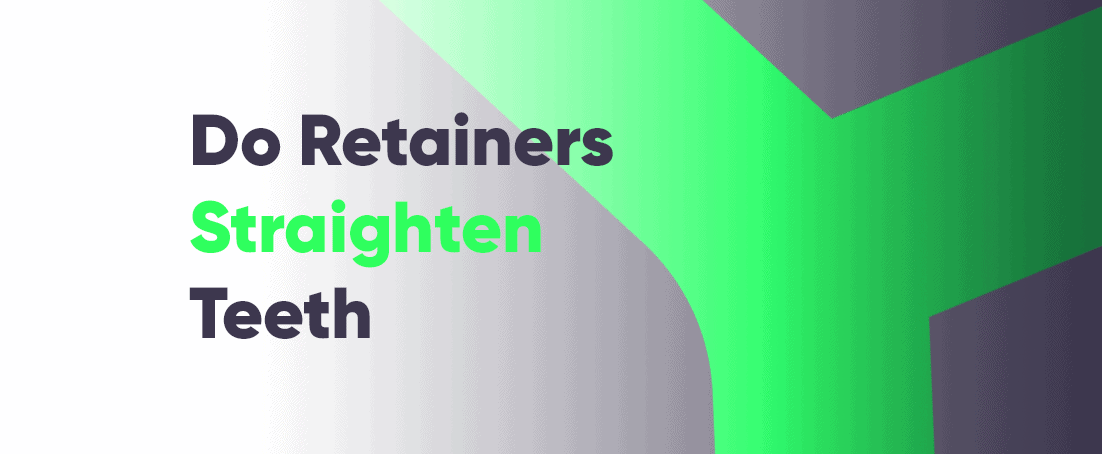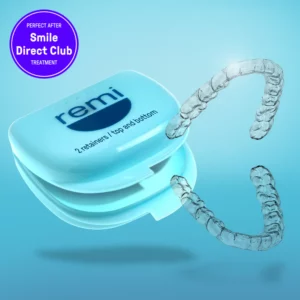
Seeking to straighten your teeth? Exclude retainers from your options, as they serve a different purpose than moving teeth to a perfected position. While a survey from Progress in Orthodontics showed that retainers are popular after widening upper teeth, they are for maintaining alignment, not major straightening.
Clear retainers often get mistaken for clear aligners, leading many to believe they can straighten teeth. Similarly, the metal clasps and wire on Hawley retainers, along with the bonded wire of permanent retainers, may confuse people into thinking they can move teeth like braces.
Dive in to discover the truth about retainers and find effective ways to achieve your smile goals!
Clarifying the Purpose of Retainers (Post-Orthodontic Stabilization)
It’s important to learn about the distinct role of each orthodontic tool, whether they are aligners, braces, or retainers. One needs to understand that they work together for a successful outcome, but in different ways.
Braces or aligners are the workhorses of the treatment phase. They apply constant, gentle pressure to move your tooth into the desired positions gradually.
Dental retainers, on the other hand, come in after the braces or aligners come off. Their primary purpose is to stabilize your teeth and prevent them from shifting back towards their original positions. They preserve the beautiful outcome achieved through active treatment.
While it doesn’t actively move teeth, a retainer will ensure your new smile stays put. Without retainers, your teeth do tend to drift back over time, negating all the hard work done with braces or aligners.
By following your orthodontist’s instructions and wearing your retainers faithfully, you can ensure a long-lasting, healthy smile that you’ll love!
How Retainers Work
While braces and aligners actively move your teeth, they don’t solidify them in their new positions immediately. The surrounding bone and tissues need time to adapt and rebuild around the adjusted tooth. This is where a mouth retainer steps in.
Retainers can be both removable and less conspicuous than metal braces. They apply constant, light pressure that holds your teeth in place. This pressure guides the bone tissue to remodel and solidify around their new alignment, essentially creating a stable foundation for your new smile.
The Bone Remodeling Process:
Bone is a living tissue that constantly undergoes remodeling. This means old bone is broken down and replaced with new bone based on the forces it experiences. By wearing your retainers as instructed, you provide the necessary gentle pressure to signal the bone to rebuild around your teeth in their new positions.
This natural bone remodeling process takes time, often months or even years. That’s why wearing your retainer consistently, typically for extended periods as directed by your orthodontist, is crucial. Without this prolonged stabilization, your teeth could gradually drift back towards their original positions due to natural forces like chewing and muscle pressure.
Common Teeth Straightening Misconceptions
While it might seem like your teeth are magically shifting with your retainer, there’s a common misconception at play. Unlike the active teeth-shifting power of braces or aligners, retainers are all about maintaining the beautiful alignment you’ve already achieved.
Retainers act as gentle guardians for aligned teeth. By applying light, consistent pressure, retainers keep each tooth from wandering back. They don’t actively push or pull teeth into new positions, but rather ‘retain’ them where they are.
If your teeth have shifted a little bit after not wearing your retainer for some time, putting the retainer back on might help move them back to their original position. But for major corrections, you’ll need to revisit your trusty braces or aligners.
There are various kinds of retainers, like removable Hawley retainers, clear plastic retainers, and even permanent bonded teeth retainers. Each functions differently, but their core mission remains the same: guarding the alignment of your teeth.
Retainer Effectiveness Factors
While retainers are crucial for post-treatment stability, their effectiveness can vary depending on your unique orthodontic journey. Several factors influence how well they hold your smile in place:
- Complexity of treatment: Did you have simple alignment issues or complex bite correction? More involved cases might require prolonged retainer wear (think years!) to ensure lasting results.
- Individual biology: How quickly your body remodels bone can impact retainer effectiveness. Slower remodeling might necessitate more consistent retainer use to maintain alignment.
- Type of retainer: Removable and fixed teeth retainers offer different levels of stability. Your orthodontist will recommend the most suitable option based on your case. When using a clear removable retainer, ensure it fits snugly and feels comfortable. If a retainer doesn’t fit properly, it won’t provide optimal prevention of teeth movement.
- Compliance: Skipping retainer wear, even occasionally, can lead to shifting teeth. The effectiveness of any retainer depends on consistent wear as directed by your orthodontist. Choosing comfortable, well-fitting retainers, such as Remi, makes this process easier and increases your chances of maintaining your beautiful smile

Realistic Expectations After Active Treatment
While the retainers won’t continue teeth straightening, they are vital for lasting results of the prolonged treatments done using braces or aligners. Remember, each tooth has a “memory” and wants to return to its old position. Retainers resist the movement with their gentle and constant pressure, stabilizing your new alignment.
It’s important to understand that retainers are designed to maintain your teeth’s alignment rather than actively correcting any major shifts. If you happen to miss wearing your retainer for a while, you might notice some slight changes in your teeth position. Should your teeth shift due to not wearing a retainer post-treatment, your orthodontist may suggest wearing braces or aligners again. But that completely depends on the amount of shifting and which teeth have moved.
Consistently wearing your retainer is crucial for keeping your smile looking its best in the long run. So, while it can help prevent further movement, don’t expect the retainer to work miracles if you’ve missed some wear time.
F.A.Q.
1. Can wearing retainers straighten crooked teeth?
Retainers maintain your post-treatment smile, not actively move teeth. Braces or aligners are the tools for big changes, including straightening crooked teeth.
2. How long should I wear my retainer to keep my teeth straight?
Most patients are advised to wear retainers for at least 10 years, and for some, lifetime wear may be recommended. The duration depends on factors like the initial orthodontic condition’s severity and the type of treatment received. For a detailed explanation, check out our article “When Can I Stop Wearing My Retainers?”
3. Will wearing retainers straighten teeth for individuals with severe misalignments?
Retainers are primarily for maintaining teeth position, so they may not effectively straighten severe misalignments without additional orthodontic treatment.
4. Are there age restrictions for using retainers to straighten teeth?
There are usually no age restrictions for using retainers; they can be beneficial at any age to maintain teeth alignment. However, they are not designed for teeth straightening but to maintain the results of orthodontic treatment.
5. Can I get a replacement retainer if mine is lost or damaged?
If your retainer is lost or damaged, contact your orthodontist promptly for a replacement to avoid teeth shifting. Don’t wait, as missing your retainer can lead to teeth shifting. Get further useful advice about what to do if you lost your retainer in our blog.
Final Words
We have answered the question “Can retainers fix misaligned teeth?” comprehensively in this blog.
Remember, teeth straightening is one thing, and keeping teeth straight is another! While braces or aligners work their magic to move each tooth to a correct position, a retainer works by holding your teeth in their new position while the bone has time to remodel and rebuild around them. Don’t fall prey to the misconception that the retainer straighten teeth – Its mission is to gently stabilize your new alignment.
So, wear your retainer faithfully, following your orthodontist’s advice. Think of it as an investment in a lifetime of happy smiles, not just a temporary post-treatment phase.



